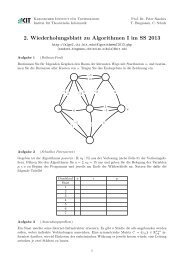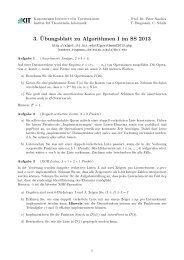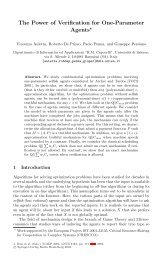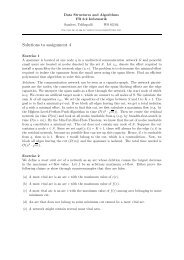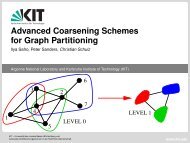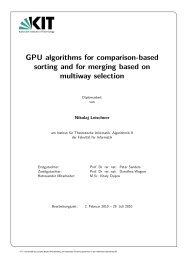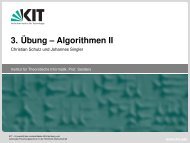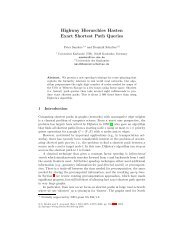Stxxl : Standard Template Library for XXL Data Sets - Max-Planck ...
Stxxl : Standard Template Library for XXL Data Sets - Max-Planck ...
Stxxl : Standard Template Library for XXL Data Sets - Max-Planck ...
Create successful ePaper yourself
Turn your PDF publications into a flip-book with our unique Google optimized e-Paper software.
LEDA-SM and TPIE libraries currently offer only single disk external memory algorithms and<br />
data structures. They are not designed to explicitly support overlapping between I/O and computation.<br />
The overlapping relies largely on the operating system that caches and prefetches data<br />
according to a general purpose policy, which can not be as efficient as the explicit approach. Furthermore,<br />
overlapping based on system cache on most of the operating systems requires additional<br />
copies of the data, which leads to CPU and internal memory overhead.<br />
The idea of pipelined execution of the algorithms which process large data sets not fitting<br />
into main memory is well known in relational database management systems [33]. The pipelined<br />
execution strategy allows to execute a database query with minimum number of external memory<br />
accesses, to save memory space to store intermediate results, and to obtain the first result as soon<br />
as possible.<br />
The design framework FG [13] is a programming environment <strong>for</strong> parallel programs running<br />
on clusters. In this framework, parallel programs are split into series of asynchronous stages,<br />
which are executed in the pipelined fashion with the help of multithreading. The pipelined<br />
execution allows to mitigate disk latency of external data accesses and communication network<br />
latency of remote data accesses. I/O and communication could be automatically overlapped with<br />
computation stages by the scheduler of FG environment.<br />
2 <strong>Stxxl</strong> Design<br />
<strong>Stxxl</strong> is a layered library; it consists of three layers (see Figure 1). The lowest layer, the<br />
Asynchronous I/O primitives layer (AIO layer) abstracts away the details of how asynchronous<br />
I/O is per<strong>for</strong>med on a particular operating system. Other existing external memory algorithm<br />
libraries rely only on synchronous I/O APIs [11] or allow reading ahead sequences stored in a file<br />
using the POSIX asynchronous I/O API [22]. These libraries also rely on uncontrolled operating<br />
system I/O caching and buffering in order to overlap I/O and computation in some way. However,<br />
this approach has significant per<strong>for</strong>mance penalties <strong>for</strong> accesses without locality. Un<strong>for</strong>tunately,<br />
asynchronous I/O APIs are very different on different operating systems (e.g. POSIX AIO and<br />
Win32 Overlapped I/O). There<strong>for</strong>e, we have introduced the AIO layer to make porting <strong>Stxxl</strong><br />
easy. Porting the whole library to a different plat<strong>for</strong>m (<strong>for</strong> example Windows) requires only<br />
reimplementing the AIO layer using native file access methods and/or native multithreading<br />
mechanisms. <strong>Stxxl</strong> has already several implementations of the layer which use different file<br />
access methods under POSIX/UNIX systems.<br />
The Block management layer (BM layer) provides a programming interface simulating the<br />
parallel disk model. The BM layer provides abstraction <strong>for</strong> a fundamental concept in the external<br />
memory algorithm design – block of elements. The block manager implements block<br />
allocation/deallocation allowing several block-to-disk assignment strategies: striping, randomized<br />
striping, randomized cycling, etc. The block management layer provides implementation of<br />
parallel disk buffered writing [21], optimal prefetching [21], and block caching. The implementations<br />
are fully asynchronous and designed to explicitly support overlapping between I/O and<br />
computation.<br />
The top of <strong>Stxxl</strong> consists of two modules. The STL-user layer provides external memory<br />
sorting, external memory stack, external memory priority queue, etc. which have (almost) the<br />
same interfaces (including syntax and semantics) as their STL counterparts. The Streaming layer<br />
provides efficient support <strong>for</strong> pipelining external memory algorithms. Many external memory<br />
algorithms, implemented using this layer, can save factor of 2–3 in I/Os. For example, the<br />
algorithms <strong>for</strong> external memory suffix array construction implemented with this module [15]<br />
require only 1/3 of I/Os which must be per<strong>for</strong>med by implementations that use conventional data<br />
structures and algorithms (either from <strong>Stxxl</strong> STL-user layer, or LEDA-SM, or TPIE). The win<br />
is due to an efficient interface, that couples the input and the output of the algorithm–components<br />
3




